The Littlewood Treaty, The True English Text of the Treaty of Waitangi, Found
Chapter: Précis 1 2 3 4 5a, 5b, 5c, 5d, 5e 6 7 8 9 10 11 12 13 14 15 16 17 18 19 20 Lord Normanby's Brief Additional Resources
Chapter 1
THE FINAL ENGLISH DRAFT OF THE TREATY IS REDISCOVERED AFTER BEING LOST FOR 149-YEARS
Who could possibly have imagined that the passing of an elderly lady named Ethel Littlewood of Pukekohe on the 27th of February 1989, would set off a chain of events with the potential to change the whole political future of New Zealand?
A couple of weeks after the funeral of their mother, John Littlewood and his sister, Beryl Needham were engaged in the unenviable duty of organising the affairs of the deceased estate and sorting through their mother’s papers. Beryl was going through the drawers of a sideboard in the living room and found, lying between linen tea towels, an envelope with handwriting on it.

The ball-point pen scrawled title on the back of the recent-era
envelope said, “Treaty of Waitangi”. Beryl placed the envelope
amongst other papers that she had set aside to read through later when she
returned to her home.
A day or two went by before Beryl got around to opening the envelope and
spreading it’s content, a single, folded and frayed sheet of paper
with ink-pen writing on both sides, out on a table. It was immediately apparent
to Beryl that this was something of importance, as the old-looking, handwritten
text was obviously in connection with the Treaty of Waitangi. The flip side
of the sheet bore a signature, William Hobson, Lieutenant Governor and a
date written as the 4th of February 1840.
There had been a long-standing tradition in the family that a predecessor, Henry Littlewood, John and Beryl’s great-grandfather, had somehow been involved in the signing ceremony of the Treaty of Waitangi and had retained a significant document associated with the treaty events of February 5th & 6th 1840. Henry Littlewood had been a prominent solicitor in New Zealand from as early as 1838 until his death, in Auckland, in 1864. Although John and Beryl’s parents had mentioned the existence of the document from time to time, it was always assumed to be in the possession of another branch of the family, the Hamilton’s.
The two creases on the sheet, where the paper had been unfolded and re-folded many times, were so worn from use that cellophane sticky tape had been applied, at some era, to stop the paper from falling apart. The tape itself was now very brittle, cracked and yellow with age, indicating that it had first been applied to the seriously frayed creases several decades earlier.
Some weeks passed before Beryl took the old document to her local Member of Parliament, the Hon. Bill Birch. After scrutinising the sheet, Mr. Birch suggested that it should be delivered to the Auckland Institute & Museum for assessment by historians and document experts there. This Beryl did on the 1st of May 1989 and the old piece of paper was formally placed into the care of a Mr. Thwaite. The receiving historian, after an initial assessment, expressed the opinion that Lieutenant-Governor William Hobson could, possibly, have penned the document. Mr. Thwaite further promised Beryl that historians and document-restorers would carry out ‘identification and conservation’ work on the potentially important item. Beryl took this to mean that the document’s handwriting would be checked by experts to determine the author and that the paper would receive preservation treatment, in order to arrest any further deterioration.
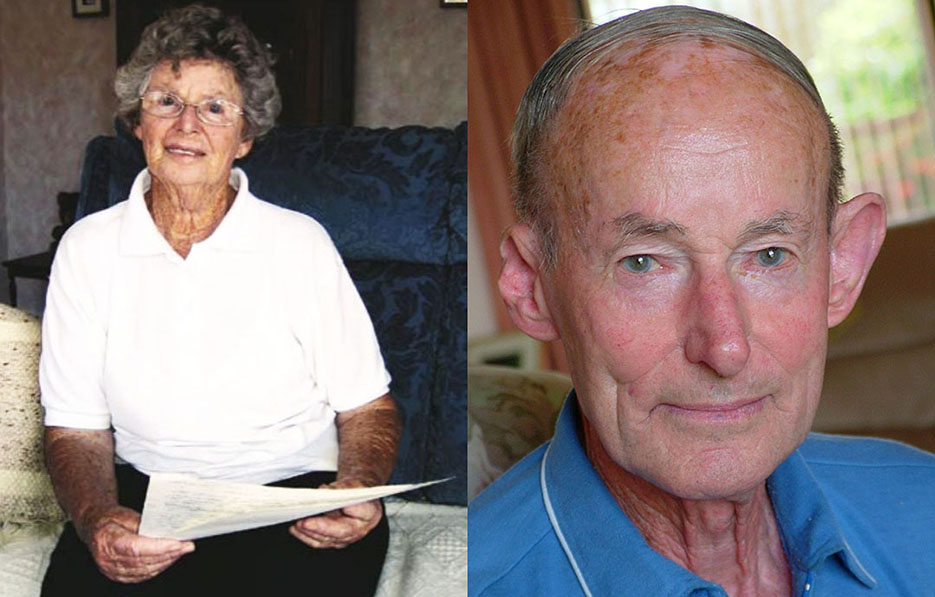
Beryl Needham (neé Littlewood) holds a copy of the the English language text of the Treaty of Waitangi that she located in a sideboard drawyer during the sorting of her mother's estate. The document found by the Littlewood's was later taken by Beryl's brother John (right) to Auckland Institute and Museum for proffesional opinions as to it's historical importance.
In reflection, one would think that a “treaty document find” of this magnitude would have sent a ripple of excitement and anticipation throughout the entire research community. However, nothing was said publicly about the find in 1989 and few, if any, of our treaty historians seemed to know that the document even existed between 1989 and 1992.
Here’s what John Littlewood lodged at the Museum:
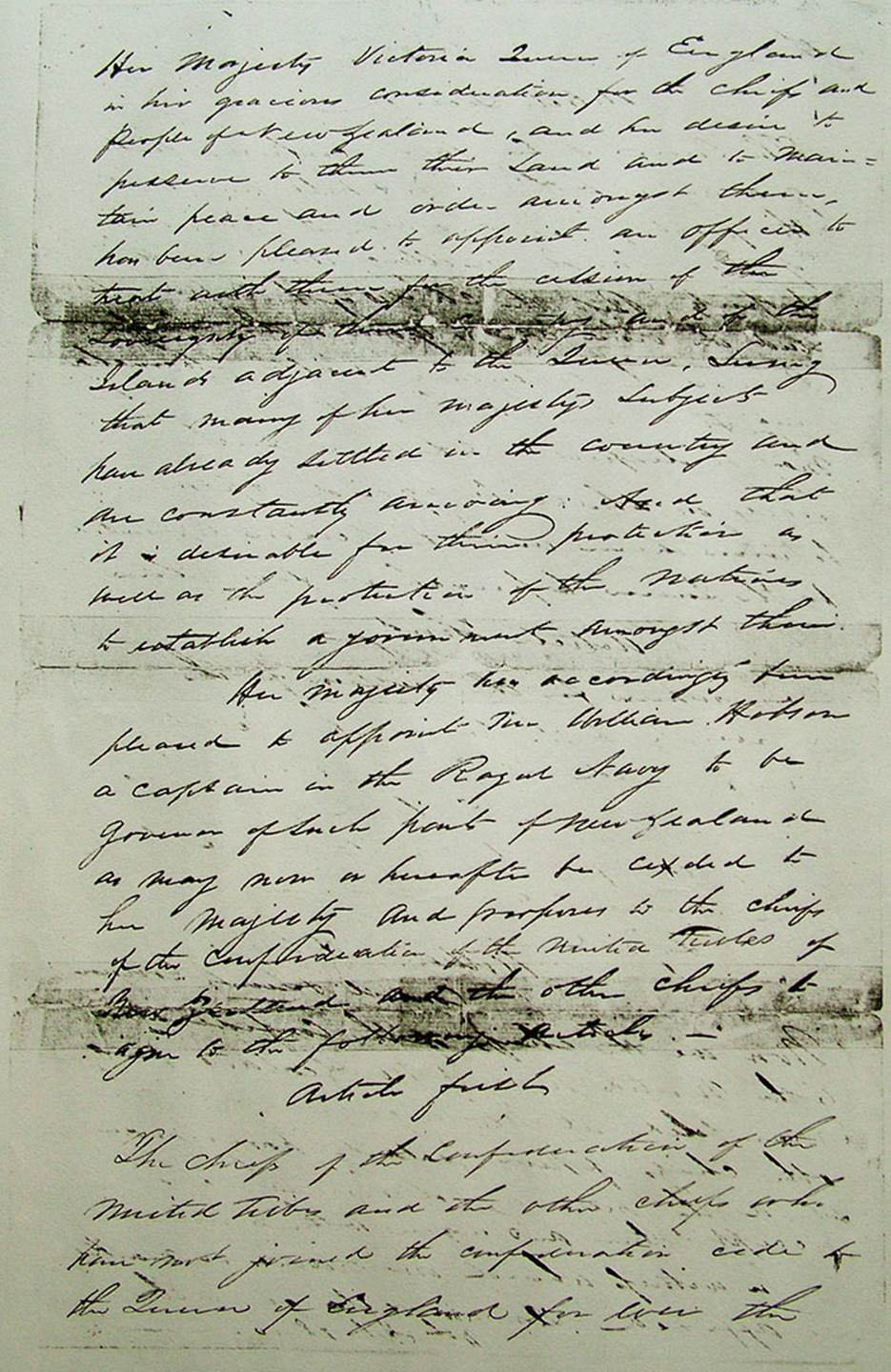
Side 1.
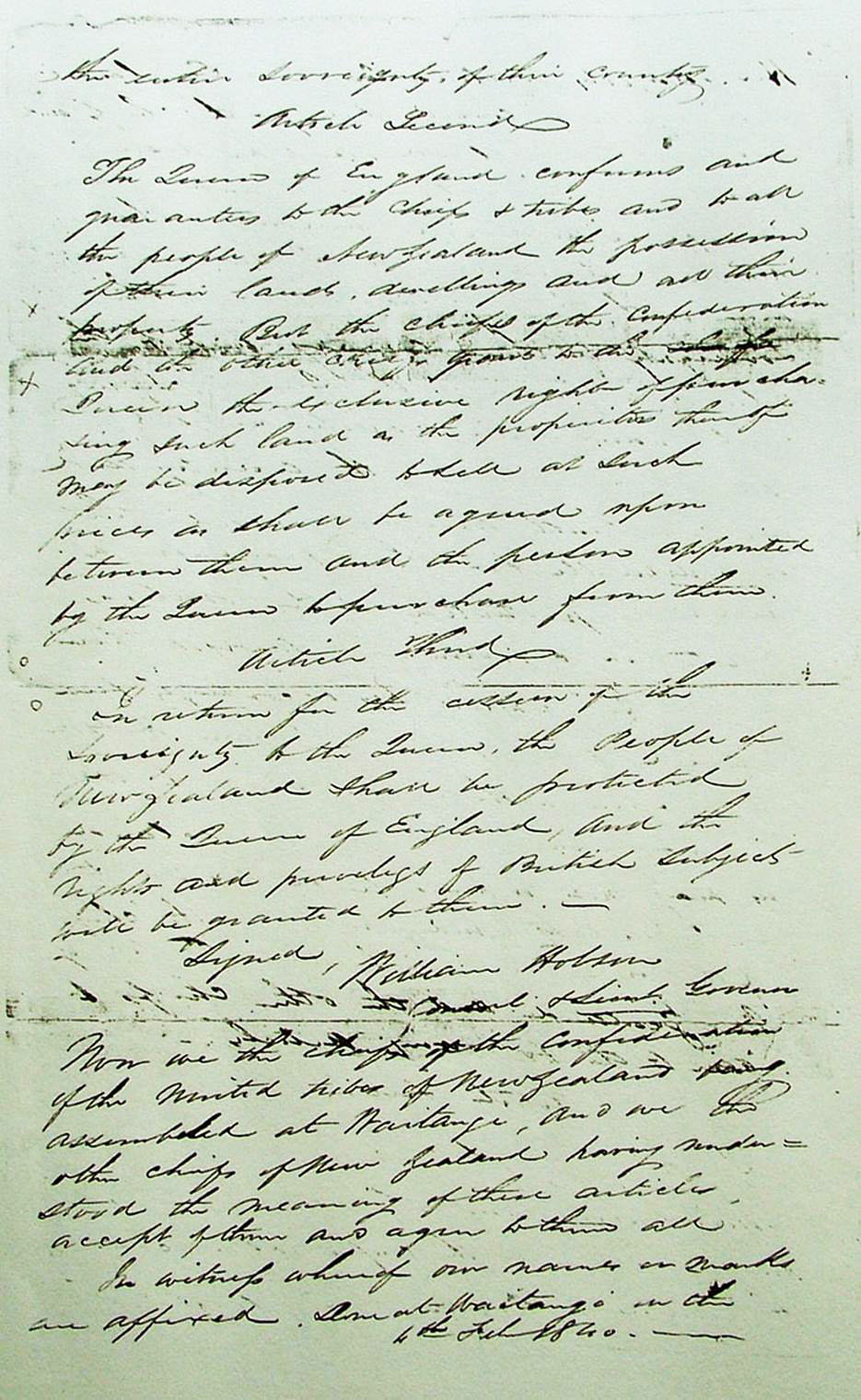
Side 2.
The Littlewood document, still marred by old cellophane sticky tape on its folds when John Littlewood placed it into the care of the Auckland Institute & Museum on May 1st 1989.
THE LITTLEWOOD TREATY …4th of February 1840.
This is what it said:
Her Majesty Victoria, Queen of England in Her gracious consideration for the chiefs and people of New Zealand, and her desire to preserve to them their land and to maintain peace and order amongst them, has been pleased to appoint an officer to treat with them for the cession of the Sovreignty of their country and of the islands adjacent to the Queen. Seeing that many of Her Majesty’s subjects have already settled in the country and are constantly arriving; And that it is desirable for their protection as well as the protection of the natives to establish a government amongst them.
Her Majesty has accordingly been pleased to appoint me William Hobson a captain in the Royal Navy to be Governor of such parts of New Zealand as may now or hereafter be ceided to her Majesty and proposes to the chiefs of the Confederation of the United Tribes of New Zealand and the other chiefs to agree to the following articles.-
Article first
The chiefs of the Confederation of the United Tribes and the other chiefs who have not joined the confederation, cede to the Queen of England for ever the entire Sovreignty of their country.
Article second
The Queen of England confirms and guarantees to the chiefs
& tribes and to all the people of New Zealand the possession of their
lands, dwellings and all their property. But the chiefs of the Confederation
and the other chiefs grant to the chiefs Queen, the exclusive right of purchasing
such land as the proprietors thereof may be disposed to sell at such prices
as shall be agreed upon between them and the persons appointed by the Queen
to purchase from them.
Article Third
In return for the cession of the Sovreignty to the Queen, the people of New Zealand shall be protected by the Queen of England and the rights and privileges of British subjects will be granted to them.-
Signed,
William Hobson
Consul & Lieut. Governor.
Now we the chiefs of the Confederation of the United tribes
of New Zealand being assembled at Waitangi, and we the other chiefs of New
Zealand having understood the meaning of these articles, accept of them
and agree to them all.
In witness whereof our names or marks are affixed. Done at Waitangi on the
4th Feb. 1840.-
Note: The word “Sovereignty” was misspelled each
time it was written, (leaving out the first "e"). The word “ceded” is once spelt as “ceided” with the “i”
crossed out. In Article II the word "chiefs" is crossed out and "Queen" written in to replace it. These little mistakes would later become very important when determining the pedigree of the document back to February, March and April 1840.
John left the document at The Auckland Institute & Museum for almost an entire year, but, when
no information was forthcoming, went and retrieved it on April 9th 1990.
The sheet of paper had, by that time, been worked over by document restorers,
who had painstakingly removed the old, dried out and fragmented cellophane
tape from its frayed folds.
When John received the document back into family custody, it was laminated
and sealed within a clear protective pouch of rigid plastic. The formerly
promised preservation work had, apparently, been carried out, but the family
were still no wiser concerning the author or significance of their mysterious
document.
Over the next two years John undertook a historical search of his own, trying to ascertain what the pedigree of the old sheet was and how his great grandfather, Henry Littlewood, might have acquired it. On the 7th of April 1992, John and Barbara Littlewood went on a research excursion to the Waitangi Treaty House near Kerikeri, Northland and had an interview with the curator, Tim Jackson concerning their document find. Mr. Jackson was, very obviously, impressed by what he saw and promised John that he would contact the Waitangi Trust and inform them that a new, heretofore unknown, English treaty draft had been discovered. He also said he would contact the Busby family of Gisborne and, similarly, alert them of the find. No added information was ever forthcoming from Mr. Jackson, the Waitangi Trust or the Busby family.
In furthering his investigations through resources at the public library, John found a book by treaty expert, Dr Claudia Orange of the Alexander Turnbull Library. He wrote a letter to Dr. Orange on the 3rd of July 1992, telling her of the document that had been found amidst family papers in early 1989. As it turned out, Dr. Orange lived not too far from John and Barbara on the opposite side of Auckland City and was able to call by their home and see them on the 11th of July 1992. She inspected the old paper closely and noted that it had a W. Tucker 1833 watermark impregnated into its surface. This showed that the sheet predated, but was very contemporary to, the time of the Treaty of Waitangi drafting process or signing ceremony in the first week of February 1840.
Although Dr. Orange could not commit herself to any definitive conclusions prior to conducting further, in-depth scientific and historical analysis, she was sufficiently impressed by what she saw to state, ‘It could be the one that was known about, but never located’. She was referring to, what has come to be known as, “the lost final draft” of the Treaty of Waitangi in English.
Dr. Orange, in her comments to John and Barbara, noted that either Lieutenant-Governor William Hobson or Reverend Henry Williams could have written the Littlewood Treaty. She also speculated that it could be a very early back-translation of the Maori text version. These several encouraging statements, although arising only in casual conversation during a cursory, first inspection of the old handwritten sheet, were no small admissions for a professional historian. Indeed, in New Zealand historical circles it would be difficult to conceive of any formerly known-about, lost document more sought-after and significant to our colonial history. By her own admission, the possibility was that Dr. Orange was looking at and handling the elusive final English draft of the treaty, which had evaded detection for the past 150-years. Most historians will live out the entirety of their professional lives and never be a party to a discovery of this immensity. Such a find, for a treaty historian, would be on a par with a Bible historian finding a lost epistle of St. Paul. Dr. Orange continued to be of assistance to the Littlewood’s during the months that followed and frequently supplied them with archival material related to their 1812-1864 ancestor, solicitor Henry Littlewood.
In early July 1992, Beryl Needham, who first discovered the Littlewood Treaty in a living room sideboard drawer, contacted Vanya Rothwell of DESTOW (Descendants of European Signatories to the Treaty Of Waitangi). As a consequence, Vanya went to Auckland on the 16th of July 1992 to view the original document at John and Barbara’s home in Manurewa. During her visit, John recalls how she stated her opinion that, ‘she was 98% sure the Littlewood Treaty was the original, final draft of the Treaty of Waitangi’. Vanya remembers that the Littlewood Treaty sheet was now laminated within protective plastic, which had been done by the Auckland Institute & Museum staff in 1989. Thereafter, some DESTOW members included a short article about the Littlewood Treaty in their magazine and asked their members for assistance in determining the document’s historical significance.
After 3-years of seeming indifference shown by our scholars
towards the find, things began to percolate and hot up in mid-July 1992.
Dr. Claudia Orange had reported back her initial conclusions to Kathryn
Patterson, Head Archivist of the National Archives in Wellington, regarding
the historical potentialities of the document.
On the 15th of July John received a letter from Kathryn Patterson requesting
that the document be lodged permanently with them. Dr. Orange phoned John
on both the 19th and 20th of July and seemed somewhat anxious or concerned
for the document’s future safety. In an 8:30 a.m. call to John on the
20th, especially, she suggested, quite strongly, that the document should
be deposited with the National Archives in Wellington as soon as possible.
She mentioned that ‘certain wording within the text might cause
particular individuals to not want the document to become public knowledge’.
Also, she intimated, ‘opportunists, aware of the existence of such
a valuable item in a private home, might wish to break in and steal it’.
A similar alerting phone call was received from Kathryn Patterson of the
National Archives and, on the 20th of July 1992, John, in sober reflection,
decided to deposit the old sheet of paper into National Archives’ care.
On the 22nd of July 1992, John and Barbara drove to Wellington and the next morning formally surrendered the long held family heirloom to Head Archivist Kathryn Patterson. John and Barbara were assured that the document would be analysed by handwriting experts to determine its author, that the paper would undergo any necessary preservation processes within Preservation Services and that it would be put on display in the Constitution Room beside the other historic treaty documents.
A short time after lodging the Littlewood Treaty with the Archives John received some photocopies of it in the mail for distribution to senior members of the Littlewood family. In the years to follow, John’s photocopy seems to have been the only source of images of the Littlewood Treaty document that members of the public could acquire. Researchers state that when they applied directly to the Archives for copies, their requests were turned down on one pretext or another. It’s unknown if the National Archives ever made so much as one copy available to anyone, other than to their own stable of approved historians.
For only a very short period in 1992 the Littlewood Treaty, as it came to be called, went on display in the Constitution Room of the National Archives, before disappearing completely from public view and scrutiny for about the next 9 years. At all times that it has been displayed, only the front page could ever be seen, thus keeping the telltale date of its creation, the 4th of February 1840, out of sight and out of mind for anyone discerning enough to realise the significance of that written date.
By some means, as yet not established, the media were alerted about the Littlewood Treaty’s existence, which resulted in TV1 contacting John in early September 1992 and asking him to be interviewed on camera. John, a very unassuming and private person, did not wish to appear and so the producer contacted Beryl, who agreed to be interviewed. On about the 11th of September 1992 news was nationally broadcast for the first time to all the people of New Zealand that a very old copy of the treaty, in English, had been located at Pukekohe, South Auckland.
TV3, not to be outdone, followed up on the story some 3-days later and arranged to film a photocopy reproduction of the Littlewood Treaty document at John’s home, on the understanding that John would not be required to appear on camera. During the filming session the camera panned around the room, catching John unawares and, against his stated wishes, his image was, thereafter, broadcast into living rooms all over the country.
The breaking of the story, nationally, appeared to make an indelible impression upon the Minister of Internal Affairs, the Hon. Graham Lee, who, in a newspaper interview of September 11th, 1992, expressed his department’s ‘irritation’ that knowledge of the Littlewood Treaty had been made public. John received a phone call from Mr. Lee, who asked him to ‘jump on a plane and come to Wellington immediately’ so that a planned programme could be devised on ‘how to handle all of this publicity’. John, wishing to shun any further interviews himself, declined Mr. Lee’s invitation to participate, expressing his feeling that New Zealanders were now fully aware of the existence of the newly found treaty document.
The family had acted as guardians, preserving the precious item intact for, perhaps, 140 to 150-years. Now it was time for the historians, handwriting and forensic experts to fulfil their roles in behalf of an expectant, eager-for-updates public. The treaty research community and many other interested parties wished to know if this was, indeed, the lost and long sought-after, final English draft of the Treaty of Waitangi, which had disappeared from the historical scenery on or shortly after the 6th of February 1840.
Despite the very reasonable expectation that our experts would complete the simple task of analysis fairly quickly, the general public was destined to wait in vain. The desired answers to very basic historical or forensic questions would never be shared publicly at any time during the next twelve years, if ever. It became increasingly obvious that the Littlewood Treaty was a most unwelcome discovery in certain political circles and was to be kept under wraps permanently…which might go some way towards explaining Mr. Lee’s mystifying and unreasonable ‘irritation’ that the find was made public.

This September 1992 article shows that our historians, at the time, thought that the Littlewood Treaty could be the final English draft of the Treaty of Waitangi and the document taken to Reverend Henry Williams at 4 p.m. on the 4th of February 1840 for translation into the Maori language. These many years later the public still awaits the promised forensic analysis and verification, related to this very important historical point.
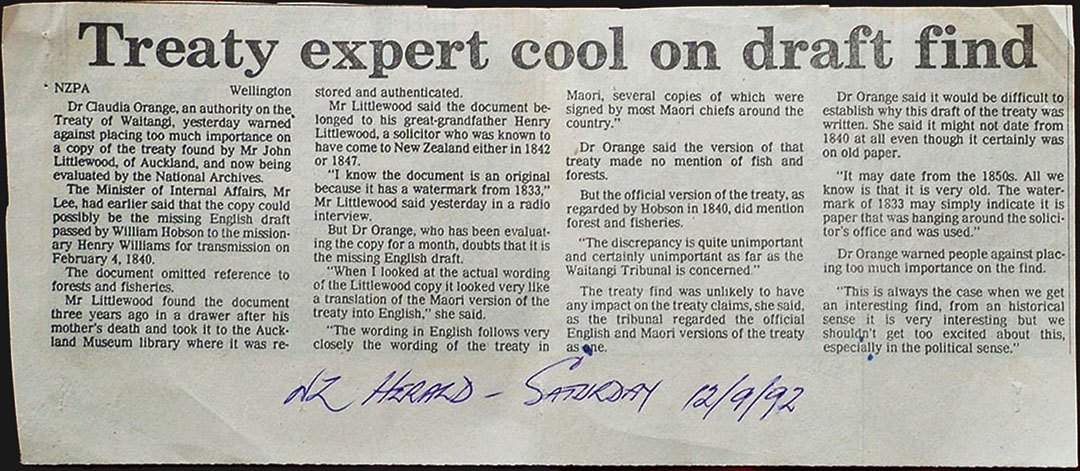
Some of the logic proffered by Dr. Claudia Orange, in her 1992 commentary about the attributes of the Littlewood Treaty document, is quite difficult to fathom. The fact that its wording mirrors the Maori translation perfectly only indicates to Dr. Orange that it must be a back-translation from the Maori. She concludes this despite the clearly visible fact that the Littlewood Treaty is dated the 4th of February 1840 and the Maori version did not exist until the day after that. Whereas Dr. Orange can accept that the “official” English version (which was written on the 3rd of February 1840 and is nothing like the Maori version) was the source of Williams’ translation, she cannot, seemingly, see how the Littlewood version could provide the text for the Maori Tiriti O Waitangi. This is rather bizarre. Williams, only two weeks after completing his translation, certified that it was ‘as close as the idiom of the language would admit of’...in other words, that the Maori version was a mirror of the English text he’d been handed by Hobson to use. Such an assertion could not possibly be made regarding the 3rd of February “official” English version translating (with any degree of accuracy) into Te Tiriti O Waitangi. The only way that Williams’ claim could be true is if he used the Littlewood Treaty, or something very close to it, as his English source document for creating the Maori translation. They are an exact match, whereas the 3rd of February 1840 draft English version and the Maori Tiriti O Waitangi translation are as different as “chalk & cheese”. In every respect (right down to its author, date & wording) the Littlewood Treaty document qualified as the “final English draft” that our historians knew was lost and had been seeking for over 150-years by September 1992.
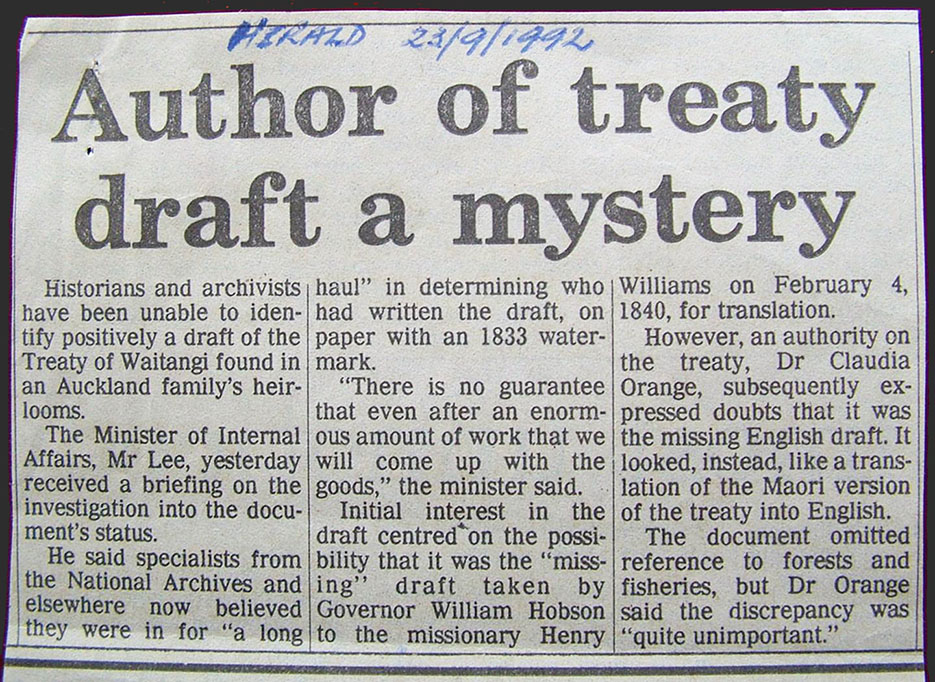
A series of newspaper articles in 1992 showed that historians
thought the Littlewood Treaty document could be the lost final English draft
of the treaty, which had been much sought-after for more than 150-years. Reflecting
on these articles over twelve years beyond the time they were first printed,
one is left to wonder why no scientifically derived results were ever released
to the public concerning the significance of the Littlewood Treaty document.
Some of the 1992 comments lead one to conclude, ‘thou doth protest too much, methinks’.
Comments from M.P. Graham Lee that, ‘the document does not rewrite history, does not change the Treaty of Waitangi’…or… his [Internal Affairs] ‘department’s irritation that news of the find had been made public’…or … ‘There is no guarantee that even after an enormous amount of work that we will come up with the goods’ …or… ‘specialists from the National Archives and elsewhere now believed they were in for “a long haul in determining who had written the draft”…show that the document find was causing considerable consternation amongst our experts.
In retrospect, and in consideration of how easy it should have been to identify the author of the Littlewood Treaty in 1992, it is mystifying that no such information was ever, officially, released to the public.
THE DEAFENING SILENCE
The September 1992 speculation amongst our leading treaty document experts and historians showed that they believed the Littlewood Treaty could be the long-lost final English draft of the Treaty of Waitangi. It is fair to say that there was, in New Zealand historical circles, no other single document likely to engender more interest and expectation than this one.
Every leading treaty expert knew that the final English draft of the treaty, the mother document from which the Maori Tiriti O Waitangi had been translated, went missing sometime just after the Treaty of Waitangi discussion and signing events of February 5th and 6th 1840.
Inasmuch as it was the final English draft, which led to the creation of the Maori language version, this English text must have been what Captain William Hobson read to the crowds, on two consecutive days, at the Waitangi assemblies. We know from the writings of Reverend Colenso and other witnesses that no-one present disputed the accuracy or mirror-imagery of the two versions when Hobson read the English clauses and Reverend Henry Williams repeated the same clauses in the Maori language. Some disputes arose during the much later debate period of the discussions, when Reverend Henry Williams was accused of not translating, verbatim, all that the Maori chiefs were saying to Hobson.
The task of determining whether or not the Littlewood Treaty qualified as the final English draft was quite simple and should have been decided within a few days or, at worst, a few weeks of the document coming into the possession of the experts. There wasn’t, in actuality, much to contemplate, test or mull over. The document had to meet certain very basic criteria, which were:
• The paper upon which it was written had to predate the treaty-signing event by a plausible period of time. Inasmuch as all paper used in New Zealand up to the 1840’s was being imported, one had to calculate purchase and shipping times between destinations. Most official correspondence of that era was on very good quality paper, which bore the watermark of the manufacturer and a Britannia figurine. One could broaden the investigation to ascertain who was using a particular mark of paper at the time the treaty was signed and whose batch lot the paper, used to write the Littlewood Treaty document, had come from.
• The wording had to look like a final draft; that is, it had to be set out as a clearly readable, finished and coherent text by the legislators who composed and wrote it. It had to have a complete Preamble, followed by 3 clearly written Articles, room for Hobson’s signature and title, an Affirmation section and the date. Receiving a complete final draft was imperative, such that the translators would have no difficulty in understanding exactly what was to be conveyed, in what order, during translation into the Maori language. Full responsibility for getting the compact / contract wording correct was, first and foremost, the job of the legislators. The translators had to then express those terms and conditions in the Maori tongue ‘as closely as the idiom of the language would admit of’.
In reviewing all of the 12-pages* of English draft notes that survived
in our archives since February 1840 there is, clearly, no final draft to be
found amongst them, sufficient to hand to a translator. They are, simply, very
rough, preliminary draft notes and there had to be another document beyond those
notes. The newly found Littlewood Treaty fulfils all the requirements of a final
draft perfectly in layout and wording.
*Footnote: There are, in addition, 4-pages of draft notes representing
Busby’s first attempt at writing his 3rd of February rough draft. These
pages are held at Auckland Institute & Museum. From this rough copy he made
a clean copy, which was submitted to Hobson in the evening of the 3rd of February
1840 for discussion and further modification.
• The Maori Tiriti O Waitangi is made up of specific titles, words, clauses and articles, assembled in a particular order. The mother document in English, from which the Maori text was created, should say exactly the same thing, in the same general sequence and approximate the same word weight per sentence. A peculiarity of different languages relates to the order in which parts of speech appear within a sentence. One can take into account that an adept translator might be obliged to reverse the order of some words, such that everything sounds correct to the native speaker. There should be no odd-ball words or text appearing in one version and not in the other and both versions should mirror each other ‘as closely as the idiom of the language would admit of’.
• If any date were to be written onto the final English draft, then that date would have to be the 4th of February 1840. When the final draft was handed to Reverend Henry Williams at 4 p.m. on that day, the date of any anticipated signing event was absolutely unknown. Hobson was hopeful that an agreement could be reached by the 7th of February but, during the assembly of the 5th, ‘suggested to the chiefs that they could have ample time, a week, to consider the Treaty’. The fact that the chiefs wished to sign on the 6th of February 1840 took Hobson by surprise. The final draft in English was created on the 4th of February and, therefore, should bear that date. Alternatively, Reverend Henry Williams’ original translation into Maori was also written out on an ordinary piece of paper (now lost) and not completed until the 5th of February. That paper copy, which should bear the date of the 5th of February, was used by Reverend Richard Taylor to create the parchment copy of Te Tiriti O Waitangi signed by the chiefs on the 6th of February 1840.
• Finally, and most importantly, the handwriting of the document’s
author would provide the definitive clue and our historical accounts show that
British Resident, James Busby, was the individual who wrote the final
draft. He said this himself:
‘The draft of the Treaty prepared by me was adopted by Captain Hobson
without any other alteration than a transposition of certain sentences, which
did not in any degree affect the sense’ (see Appendix to Journals, July
1861, E. No. 2, page 67).
We know from surviving draft notes that Busby wrote two sets of developing, rough drafts of the treaty Articles on the 3rd of February 1840, to which he added ideas for an ending or Affirmation section. He never actually attempted to write a Preamble section on the 3rd, as there were already two possible, rough Preamble texts to draw from, one created by William Hobson between the 31st of January and 1st of February 1840 and another by James Stuart Freeman, somewhere within the same interval of time.
Busby took over all writing duties related to the treaty by about the afternoon of Sunday the 2nd of February 1840. The final wording was decided upon during a brainstorming session held in the evening of the 3rd of February 1840, with the final words being put to paper the next morning and early afternoon.
If the Littlewood Treaty were found to be in the handwriting of James Busby, then everything would point to it being the lost, final English draft of the Treaty of Waitangi. It fitted the clinically precise, historically stringent, defining attributes of the final draft in all other categories, as it was complete in all sections and its wording mirrored the Maori text perfectly.
In a purely scientific sense, there was never so much as one flaw in the Littlewood Treaty, sufficient to dissuade our experts from believing that it could be anything other than the final English draft of the Treaty of Waitangi. Whereas it always had the potential to rein-in and arrest the social havoc caused by those running amok with our treaty, our experts did nothing. Of this dismal state of affairs, one recalls the saying, ‘Nero fiddles while Rome burns’.